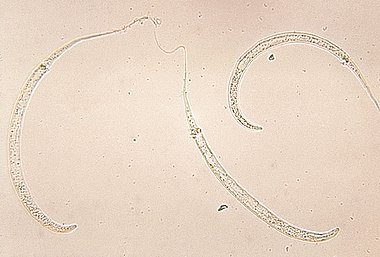|
Date & Time : 22, December 2024 17:13
General Characteristics of Nemathelminthes
• Phylum Nemathelminthes comprises of animals commonly called nematodes or roundworms.
• Nematodes are ubiquitous and are found in freshwater, marine, as well as terrestrial environments.
• Most of the species of nematodes live a parasitic life, though a number of free-living forms are also present.
• These are triploblastic, bilaterally symmetrical animals with organs system level of body organization.
• Body is elongated, cylindrical, unsegmented and vermiform.
• Size of the nematodes varies considerably in different species.
• Body is covered by a resistant, inelastic and thick cuticle which is covered by a thin and lipoid epicuticle.
• Epidermis is syncytial in nature and is invaginated into four longitudinal cords.
• Body wall has thick muscle layer composed of only longitudinal muscles which are present between four cords.
• The body cavity is a pseudocoel and is not lined by coelomic epithelium. It contains pseudocoelomic fliuid rich in proteins, and organic metabolites.
• Nematodes exhibit undulating movement in dorso-ventral plane produced by alternate contraction and expansion of the longitudinal muscles.
• Circulatory and respiratory system are absent.
• Digestive tract is straight and complete with two openings, mouth and anus.
• Flame cells are absent and excretory system consists of a few renette cells or a canal system.
• Nervous system comprises of a circum-pharyngeal nerve ring surrounding the pharynx and four peripheral longitudinal nerves.
• Sense organs are poorly developed and include amphids, phasmids, papillae, bristles and ocelli.
• Sexes are separate with distinct sexual dimorphism.
• Gonads are unpaired or paired and are tubular or coiled.
• Sexual reproduction is the common form of reproduction.
• Fertilized eggs are surrounded by a tough capsule.
• Cleavage is determinate and development includes usually four larval stages.
• Development of embryo takes place with or without intermediate hosts.
Classification of Nemathelminthes
Phylum Nemathelminthes is divided into two classes based on the presence or absence of phasmids.
a) Adenophorea or Aphasmidia
• Phasmids, the sensory organs in the caudal end, are absent.
• Amphids, the chemoreceptors are variably-shaped and are present behind the lips.
• Excretory canals are absent.
• Most species are free living and some are parasitic.
• Free living species include almost all marine forms; and some terrestrial and freshwater forms.
A few examples are Xiphinema, Mermis and Enoplus.
b) Secerenentea or Phasmidia
• Phasmids are present which open through minute pore on each side near tip of tail.
• Amphids are pore-like and are present in the lateral lips.
• Excretory canals are present.
• Most of the species are parasitic in nature.
• Free living species are soil inhabitants.
A few examples are Ascaris, Wuchereria, Oxyuris, Ancylostoma and Dracunculus
A Few Examples
1. Ascaris lumbricoides
2. Ancylostoma duodenale
3.Wuchereria bancrofti
 Dracunculus medinensis larvae |